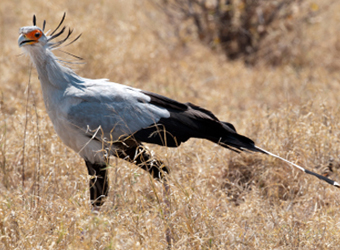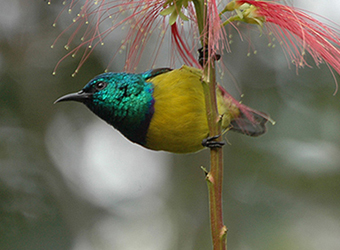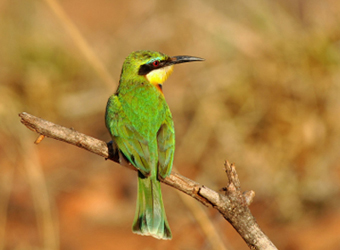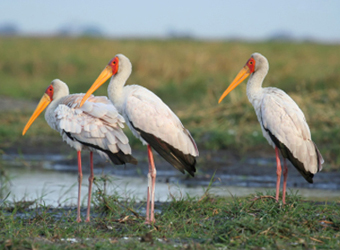Birds

Ostrich
The largest and one of the world’s most well known birds, the ostrich is found exclusively in Africa. It is also the world’s heaviest bird, measuring up to eight feet tall and weighing up to 300 pounds. Ostriches are also sexually dimorphic – males are black in color with white wing plumes and tail, and females are almost entirely drab gray. Although they still have flight feathers on their wings, they cannot fly and instead, have evolved long, powerful legs, which serve as their main mode of transportation. These large, strong legs also serve as protection from predators.
Ostriches are found throughout Africa, but contrary to popular belief, they prefer to inhabit lush, open grasslands, not deserts. They are usually silent creatures, although when either territories or females are threatened, a deep resonating “BOOM” will echo through the African bush.

Malachite Kingfisher
Malachite kingfishers are widely distributed in Africa south of the Sahara. They are small, thirteen centimeters in length. The general color of the upper parts of the adult bird is a bright metallic blue. The head has a short crest of black and blue feathers. The face, cheeks and underparts are rufous and there are white patches on the throat and rear neck sides. The bill is black in young birds and reddish orange in adults and the legs are bright red.
This bird has regular perches or stands, usually low over the water, from which it catches fish, aquatic insects and crustaceans. The fish is usually lifted and carried by its middle, but its position is changed, sometimes by tossing it into the air, before it is swallowed head downwards.

Lilac Breasted Roller
The lilac-breasted roller is widely distributed in sub-Saharan Africa. Preferring open woodland and savanna; it is largely absent from treeless places. Usually found alone or in pairs, it perches conspicuously at the tops of trees, poles or other high vantage points from where it can spot insects, lizards, scorpions, snails, small birds and rodents moving about at ground level. Nesting takes place in a natural hole in a tree where a clutch of two to four eggs is laid, and incubated by both parents, who are extremely aggressive in defense of their nest, taking on raptors and other birds. During the breeding season the male will rise to great heights, descending in swoops and dives, while uttering harsh, discordant cries. The sexes are alike in coloration. Juveniles do not have the long tail feathers that adults do.

Yellow Billed Hornbill
The two species of yellow-billed hornbill include the southern yellow-billed hornbill and the eastern yellow-billed hornbill. Found in southern Africa, the southern yellow-billed hornbill is characterized by a long yellow beak with a casque. The skin around the eyes and in the malar stripe is pinkish. They have a white belly, grey neck, and black back with abundant white spots and stripes. They feed mainly on the ground, where they forage for seeds, small insects, spiders and scorpions. Termites and ants are a preferred food source in the dry season.
The eastern yellow-billed hornbill is found in Djibouti, Eritrea, Ethiopia, Kenya, Somalia, Sudan, Tanzania, and Uganda. It resembles the southern yellow-billed hornbill, but has blackish (not pinkish) skin around the eyes.

Flamingo
The range of the greater flamingos extends across the entire shoreline of Africa. They live in large colonies, oftentimes numbering into the thousands of individuals and they tend to occupy large mud flats where the loose mud can be easily formed into the mounds that they use as nests. In colonies with such large populations, occasional food shortages arise and flocks will perform short migrations in search of greater food resources.
Flamingos are most well-known for their bright pink coloration and in fact, the word "flamingo" derives from old Spanish for "flaming" or "red feather." Individuals have long, graceful necks and legs which, in proportion to body size, are the longest of any bird. They will often rest their head on their body in order to avoid fatigue in the neck muscles.

Saddle-billed Stork
The saddle-billed stork is a large wading bird. It is a widespread species and is a resident breeder in sub-Saharan Africa from Sudan, Ethiopia and Kenya south to South Africa, and in Gambia, Senegal, Côte d'Ivoire and Chad in western Africa. The plumage is identical in males and females with iridescent black head, neck, back, wings and tail. The rest of the body and the primary feathers are white. The large bill is crimson with a black band and a triangular yellow frontal shield (or saddle). The black legs have pinkish joints at the knee. Fossil records date storks back some fifty million years. They differ from other birds in that they have no muscles in their voice boxes and, therefore communicate by rattling their bills.

Kori Bustard
The kori bustard, native to Africa may be the heaviest bird capable of flight. It is mostly grey in color, with a black crest on its head and yellow legs. The East African subspecies is found in Ethiopia, Kenya and Tanzania. The southern subspecies is distributed in southern Africa in Botswana, Zimbabwe, Namibia, southern Angola, South Africa, and southern Mozambique. Because it is a large, heavy bird, it avoids flying if possible and spends most of its time on the ground, foraging for the seeds and lizards which make up most of its diet.
Kori bustards are polygynous. One male will display to attract several females and then mate with them all, leaving them to care for the young on their own.

Grey Crowned Crane
The body of the grey crowned crane is mainly gray. The wings are predominantly white, but contain feathers with colors ranging from white to brown to gold. The head is topped with a crown of stiff golden feathers. Cheek patches are white, and a red gular sack is present under the chin. Legs and toes are black and the bill is short and dark gray. They have long hind toes that allow then to roost in trees.
All cranes engage in dancing, which includes various behaviors such as head pumping, bowing, jumping, running, stick or grass tossing, and wing flapping. Although primarily done as a part of mating rituals, dances are often performed outside of the breeding season as well.

Secretary Bird
The secretary bird is a large, mostly terrestrial bird of prey. Endemic to Africa, it is usually found in the open grasslands and savannah of the sub-Sahara. It has traditionally been admired in Africa for its striking appearance and has been a common motif for African countries on postage stamps.
The secretary bird hunts its prey on foot. Prey consists of insects, small mammals, lizards, snakes, young birds, bird eggs, and sometimes dead animals killed in grass or bush fires. It also waits near fires, eating anything it can that is trying to escape. Secretary birds associate in monogamous pairs. During courtship, they exhibit a nuptial display by soaring high with undulating flight patterns and calling with guttural croaking. Males and females can also perform a grounded display by chasing each other with their wings up and back, much like the way they chase prey.

African Masked Weaver
The African masked weaver or southern masked weaver, found throughout southern Africa, is very widespread and found in a wide range of habitats, including shrubland, savanna, grassland, open woodland, inland wetlands and semi-desert areas. It also occurs in suburban gardens and parks. It is usually seen singly or in small groups, but may also form larger flocks, alone or with other seed eating species. It eats insects, seeds and nectar.
The adult male in breeding plumage has a black face, throat and beak, red eye, bright yellow head and under parts, and a plain yellowish-green back. Exhibiting intricate nest-building techniques, African masked weavers build their nests in trees or reeds, often over water. Their nests, like those of other weavers, are woven from reed, palm or grass. A female will line a selected nest with soft grass and feathers.

African Fish Eagle
Found throughout sub-Saharan Africa, African fish eagles are found primarily along bodies of water including rivers, lakes, floodplains, coasts, estuaries, mangrove lagoons, and swamps. Their primary food source, as the name implies, is fish. An individual may consume half a pound of fish per day. Typical fishing behavior involves soaring followed by diving to the water’s surface to catch fish with their talons. It often requires several attempts before a successful catch occurs, with only one in seven to eight attempts ending in success. Adult African fish eagles are large, readily recognizable raptors, with their pure white head, neck, chest, and tail and dark chestnut brown body. They have broad, rather long wings, and a fairly short, rounded tail.

Southern Ground Hornbill
The southern ground hornbill is the largest of two species of ground hornbill (the other is the northern ground hornbill). It can be found from northern Namibia and Angola to northern South Africa to Burundi and Kenya. It is characterized by black coloration and vivid red patches of bare skin on the face and throat (yellow in juvenile birds). It lives in groups of five to ten individuals including adults and juveniles.
The habitat of the southern ground hornbill comprises savannas, woodlands and grasslands and it forages on the ground, where it feeds on reptiles, frogs, snails, insects and mammals up to the size of hares. The southern ground hornbill is a vulnerable species, mainly confined to national reserves and national parks.

Collared Sunbird
The collared sunbird is a common breeder across most of sub-Saharan Africa. Two or three eggs are laid in a suspended nest in a tree. It feeds largely on nectar, although it will also eat insects, especially when feeding its young. Although the collared sunbird can take nectar by hovering like a hummingbird, it usually perches to feed.
Found in forests near water, collared sunbirds are tiny, only three to four inches long. They have short thin down-curved bills and brush-tipped tubular tongues, both adaptations to nectar feeding. The adult male has glossy green upper-parts and head with a yellow belly and narrow purple breast band. The female is a duller green above and entirely yellow below.

Jackass Penguin
Listed on the endangered species list, the jackass penguin, also known as the African or black-footed penguin, is the only penguin species found on the African continent. They live in large colonies on rocky coastlines of southwest Africa. The name jackass penguin comes from the loud, braying, donkey-like call they emit to communicate.
At night they congregate on shore and during the day they feed in the water. They have black plumage on the back and white feathers with black markings on the chest and belly. The plumage serves as camouflage to predators, with the white appearing to aquatic predators from below and the black appearing to aerial predators from above. They also have a horseshoe-shaped white band that goes around the eye from the chin towards the beak. They feed primarily on shoaling pelagic fish and can reach speeds of up to twelve miles per hour in order to catch their prey.

Sacred Ibis
Sacred ibises are native and abundant in sub-Saharan Africa and southeast Iraq. They have all-white body plumage apart from dark plumes on the rump. Their bald head and neck, thick curved bill and legs are black and the white wings show a black rear border in flight. They inhabit a wide range of habitats, although generally they are found in close proximity to rivers, streams, and coastlines. They feed during the day primarily in flocks by wading in shallow wetlands.
Sacred ibises nest in tree colonies, often with other large wading birds such as herons. They build stick nests often in baobab trees and they generally lay two to three eggs. They feed on various fish, frogs, small mammals, reptiles and smaller birds as well as insects.

Little Bee-eater
This species, like other bee-eaters, is a richly colored, slender bird. It has green upper parts, yellow throat, black gorget, and rich brown upper breast fading to buffish ocre on the belly. The wings are green and brown, and the beak is black. Just as the name suggests, bee-eaters predominantly eat insects, especially bees, wasps and hornets, which are caught in the air from an open perch. Before eating its meal, a bee-eater removes the sting by repeatedly hitting the insect on a hard surface.
Little bee-eaters prefer areas with some open ground and reasonably low perches including bushveld, and open woodland. They lay four to six spherical white eggs and both the male and the female take care of the eggs.

Red-billed Hornbill
Red-billed hornbills are social birds that gather in small groups or pairs. Although they are large birds, they are one of the smaller hornbills. They are unique because their first two neck vertebrae are fused in order to support their large bills. Hornbills are omnivorous birds, eating fruit, insects and small animals.
When nesting, the female actually seals herself inside the nest with the eggs by building a wall of mud, food remains, and her own droppings. She will leave a small open slit, just big enough for the male to transfer food to her and her chicks. When the chicks and the female are too big to fit in the nest, the mother breaks out and rebuilds the wall and then both parents feed the chicks.

Red and Yellow Barbet
Found in eastern Africa, red and yellow barbets have strong red bills that are long, thick and pointed. They have large red to red-orange heads and are strongly patterned with blotches and spots of red, yellow, black and white. They feed on seeds, fruit and invertebrates and are found in low woodlands, savannas and scrubby areas where terrain is rugged and semi-arid.
Long duets are usually sung by the dominant pair and sound like their English name, red 'n yellow, repeated over and over. The singing pair occupy the uppermost tree branches and if other members move up or in-between the two singers, they will be forced back down. The duet also serves as a territorial song to other outside groups.

Crowned Plover
The crowned plover, also known as the crowned lapwing, occurs throughout southern Africa. It is an adaptable and numerous species, with bold and noisy habits. It is easily recognized by its red legs and combination of brown and white plumage, with most tellingly, a black crown intersected by an annular white halo.
Crowned plovers have a long breeding season and a pair may have more than one successful breeding attempt if nests or chicks are lost. They lay two eggs in a scrape in the sand, lined with vegetation or small pebbles. Egg-laying is times to precede the rainy season; the eggs take about a month to hatch and the chicks between four and five weeks to fledge. Most incubating is done by the female. The male assists only on hot days, when he either incubates or shades the nest.

Yellow-billed Stork
The yellow-billed stork, a member of the wading family, occurs in Africa south of the Sahara and in Madagascar. It favors aquatic habitats, including shallow lakes, mud flats, coastal lagoons and meadows where it feeds on crustaceans, small fish, frogs, insects and worms. Yellow-billed storks typically use one foot to stir up the water or mud which disturbs and flushes out the prey. Then they submerge their heads quickly in the water snapping their bills on small prey.
Plumage on the yellow-billed stork is mainly pinkish-white with black wings and tail. They have a bright yellow bill that is long, slightly curved and thick at the base. Their necks are also long and slender and grayish white. Their legs vary from a dark red to light pink and are long and skinny.

Helmeted Guinea-fowl
The head and neck of the helmeted guinea fowl are bare with bright blue skin and a red wattle hanging from the throat and cheeks. On top of the head sits a dull yellow or reddish bony knob which gives the bird its characteristic “helmeted” appearance. The rest of its body is covered with blackish-grey feathers dotted with white spots. These birds are terrestrial, and prone to run rather than fly when alarmed. They have a short-lived explosive flight and rely on gliding to cover extended distances.
Guinea fowl are equipped with strong claws and scratch in loose soil for food much like domestic chickens. Their diet consists of a variety of animal and plant food including seeds, fruits, greens, snails, spiders, worms and insects, frogs, lizards, small snakes and small mammals.

Marabou Stork
The marabou stork is unmistakable due to its size, bare head and neck, black back, and white underparts. It has a huge bill, a pink gular at its throat, a neck ruff, and black legs and wings. It is so large and heavy that its leg and toe bones are hollow to reduce weight during flight. The marabou stork defecates upon its legs and feet as a way to assist in regulating body temperature.
The marabou stork is a frequent scavenger, and the naked head and neck are adaptations to this, as a feathered head would become rapidly clotted with blood and other substances when the bird's head was inside a large corpse. This large and powerful bird eats mainly carrion, scraps and feces, but will also take fish, frogs, insects, eggs, small mammals and reptiles such as crocodile hatchlings and eggs.
